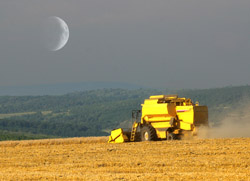 January 27, 2011
January 27, 2011
Soil, teeming with microbes and mystery, like sex, still works about as it did millennia ago. When managing soil, technology gives us more options, but not wisdom. If we use it only to prop up soil until it wears out, we’re foolish. Depleted industrial farm soil must be revitalized to grow a garden; whereas soil well managed for years sprouts more produce than can be given away. (I had that experience on farm ground converted to suburb.)
Before the technology of industrial agriculture, farmers concerned for the future knew that unless they managed the condition of the soil, yields would drop. This regularly involved unpleasantness, like redistributing manure. And arable soil is a tiny slice of the entire biosphere. Neglecting the condition of the rest of it isn’t wise either.
Food for both humans and livestock comes from topsoil. Soil is also a carbon sink; needs carbon to transform into edible carbon. Exchanges of gases between cultivated soil and the atmosphere don’t have much effect on atmospheric composition, except for nitrous oxide from excess application of nitrogen fertilizers, but soil composition is important for soil fertility. However, we’ve been losing more and more arable topsoil ever since mechanical plowing exposed more and more land to wind and water erosion.
Why? In sum, it’s eagerness to maximize yield and labor productivity year over year – incentives for industrial farming. Some of the oldest tilled ground on earth is in terraces with soil tended for thousands of years, and still productive. If we regard topsoil as an expendable commodity, we expend a capital asset necessary for life. The wisest of the ancients figured that out. The foolish ones wore out the ground and fled the scene.
Basic care of soil is old-tech, low-tech, and widely known. All gardeners putter with soil because that’s how you grow food. Remediating loss of soil on a large scale is not new either; we dealt with it in the dust bowl 1930s, planting trees and ground cover, contour plowing, rotating crops, letting land lie fallow, and so on, but doing that cuts the yield.
A few agricultural tidbits seem relevant to Compression:
- Soil with two percent or more organic matter aerates better and absorbs more water than soil with less than one percent organic matter. That can cut irrigation needs by well over half. About 65 percent of U.S. water usage is for irrigation (U.S. Geological Survey). Attacking overuse of water using higher tech gizmos may not be the only approach.
- More excess atmospheric nitrous oxide comes from U.S. agriculture than from the tailpipes of vehicles, tightly regulated for NOx emissions. Nitrous oxide is both a greenhouse gas and an ozone depleter, and runoff of excess nitrogen fertilizer is a prime cause of dead zones of eutrophication in oceans at the mouths of rivers. Nitrogen in soil is essential for growth, but plowing soil with an excess of it releases a lot to the air. (Tony Vyn, Purdue University) In the long run, we can get better results using less.
- Lawns are a form of agriculture, too. Almost 2% of U.S. land area is planted in grass, and it is a bigger consumer of “irrigation” water than any crop. Excess fertilizer used on grass it is just as potent a source of nitrous oxide as crop agriculture. (Amy Townsend-Small: U. Cal.-Irvine) So why plant so much grass to fertilize, water, and cut?
- Recent studies suggest that nutrients in crops grown today have decreased by 3-20 percent compared with 50-100 years ago. This may be due to being grown faster in basically poorer soil boosted by fertilizer. What you get is more sugar and starch, but less copper, magnesium, manganese, phosphorus, and zinc (micronutrients). Perhaps roots need to mingle deeply with soil for a longer time to absorb nutrient. Speculation then questions whether this is a factor in epidemic obesity in addition to sedentary lifestyles, food processing, and supersized portions. This emerging “controversy” bears watching.
- Another buzzword is “biochar,” touted as a practical way to increase the capacity of soil to be a carbon sink. Biochar is made by pyrolysis of waste biomass and mixed into soil. Proponents claim that if applied on big scale it could counteract the build up of CO2 in the atmosphere (geo-engineering) but they make no claims on its efficacy scrubbing other gases.
- The United States has as many people in prison as there are on farms, roughly two million. Of these, about three percent raise almost half of all production, have an operating profit margin of 16 percent, over $500,000 in sales, and over $200,000 average family income. Over half of all other farms are losing money. Some are tax write off’s for those with income from other sources. About 30 percent of the operators of small farms were over 65. (USDA figures.) This is the U.S. version of trickle-up expansion of industrial agriculture, with massive rural-to-urban migration globally, perhaps a billion people in the coming decade. So how can they learn to improve their quality of life?
How could all this affect you? Your company? Could it do anything to help customers reduce resource usage, improve their quality of life, or both?
